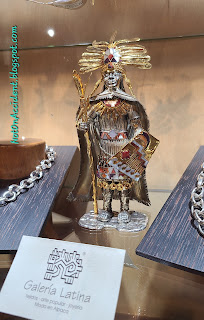Our Tuesday morning began at Galeria Latina, mostly for some shopping opportunities. The had a wide variety of handicrafts from scarves, to jewelry, to paintings, and pottery. The artists were not solely Ecuadorian, but also from other "Latin America" countries. As many of you may recall, I rarely buy souvenirs. Although the items were beautiful, I talked myself out of buying anything, much to the chagrin of many of the husbands on the tour.
From there we were off to Old Town Quito which was given UNESCO Status in 1978. We again visited the Basílica del Voto Nacional (The Basilica of the National Vow), with its lovely Gothic style architecture. On this occasion we were able to enter the church (the largest neo-Gothic basilica in the Americas). and view the interior and the courtyard outside as well.
It was built as a monument to honor Ecuador's consecration to the Sacred Heart of Jesus and was inspired by European cathedrals. All of the stone, over 7,000 tons, was locally sourced which is why there is a bit of a pink cast to much of the exterior. The church represented "Ecuador’s commitment to peace and spiritual protection in the late 19th century. As a monument of national faith, the basilica embodies the spirit of devotion and unity among Ecuadorians, highlighting the country’s deep-rooted connection to Catholicism." (source) In a distinct blending of styles, the church does not have typical European gargoyles, but figures shaped like animals native to Ecuador, such as iguanas, Andean condors, and Galápagos tortoises.
Although the idea to build the church originated in 188,3 and it was designated a Basilica in December 1985, by Pope John Paul II, it remains unfinished. As such, a legend now says that the world will end if the basilica is ever completed.
.jpg) |
| Note the large heart-shaped window above the 2 middle doors |
.jpg) |
| Chapel of the Immaculate Heart of Mary |
 |
| The First Cry for Freedom: A Story of Ecuadorian Independence |
A lovely lunch at Patio Andeluz was enjoyed by our group and we were treated to traditional espumilla for dessert. It's a type of meringue and is a popular street food here in Ecuador, often seen served on an ice cream cone.
 |
| Standing in both hemispheres |
After a wonderful "Farewell Dinner" at our hotel we said good-bye and went our separate ways. Well, sort of, there were about 15 or 16 of us on the same flight out of Quito in the morning, so we knew many of us would see each other again, bright and early!


















































